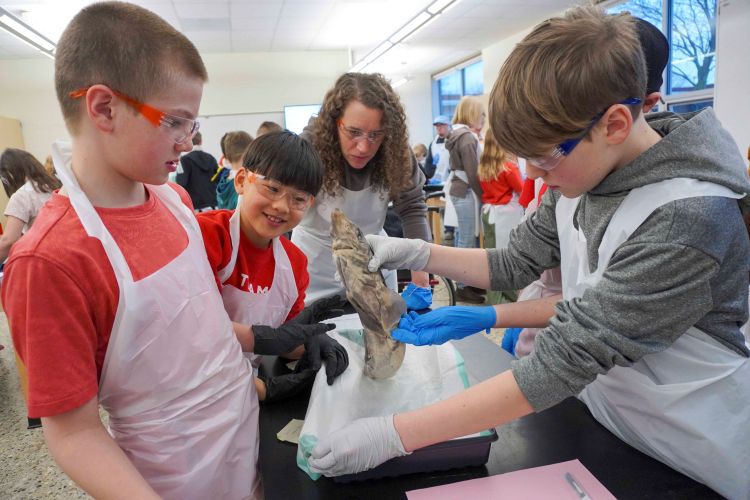Grandville — As he pried open a slice of gray flesh with a scalpel, Oakestown Intermediate fifth-grader Sawyer Rose bent his head closer to the preserved spiny dogfish shark on the table in front of him.
“What the — what is that?” he exclaimed as he pushed a gloved finger into the cavity and pulled something greenish from the shark’s stomach.
“It looks like seaweed!” said lab partner Isac Estradá-Lopez, as he poked at the stringy mass and waved to get teacher Kyle Anderson’s attention. When the teacher swung by their table, he, too, was quickly fascinated by the green goo.
“This hard part here, it looks like it could be a crustacean,” Anderson said as he examined the item. “But I can’t say for certain. I’m not sure. This is exciting stuff, though, don’t you think?”
Anderson recently led all fifth-graders at Oakestown — plus a few dozen hardy parent volunteers — in the school’s first-ever spiny dogfish dissection. He said the activity was an exploratory one meant to complement the fifth-grade curriculum that includes ocean sciences, freshwater sciences, the hydrosphere and geosphere, and more.
“(Spiny dogfish) are an interesting species; their anatomy is pretty representative of sharks (as a whole),” Anderson said. “Plus, it’s a high-interest activity. It’s not a particular focus of the (fifth-grade) curriculum, but we did do a unit on human body systems earlier this year … so this can be another spot to plant a little bit of interest in the medical sciences.”
‘I feel like a real scientist at work; it teaches you about anatomy and gives you more curiosity and an understanding of, like, life.’
— fifth-grader Izzy Broom
‘Amazing, and gross, and all of the above’
Dressed in gowns, gloves and goggles, students started the dissection by simply touching and examining the sharks to get comfortable with the specimens. Anderson walked them through several parts of the external anatomy before inviting them to take up scalpels and carefully slice down the middle of each shark’s belly.
With the innards exposed, the real effort began as each group worked to identify organs such as the heart, liver, brain and stomach. They cut into the livers to discover an oily substance, which gives the animals buoyancy in the water, and examined the cartilage inside the brains, which gives that organ a tougher texture. One group even learned that their shark was female, as they discovered a uterus with tiny spiny dogfish pups inside.
Fifth-grader Jonah York was particularly enamored with the dogfish’s eyeballs, which he described as looking “like a piece of lemon candy.”
“Our fish still had its eye in there, so I took it out and was trying to show it off, but I accidentally squished it,” he said with glee. “Luckily I had my goggles on, because it splashed a little. It’s amazing, and gross, and all of the above.”
Classmate Izzy Broom is considering becoming a marine biologist one day, so she was particularly interested in the process — but from a slight distance, she noted.
“I’m not into the cutting part, and I don’t really want to touch the organs that much; I’m more of, like, an observer,” she said. “And it smells like a Long John Silver’s or something in here. But I think it’s really fun if you get past (the smell), because I think sea creatures are so cool.
“I feel like a real scientist at work; it teaches you about anatomy and gives you more curiosity and an understanding of, like, life.”
Anderson thinks fifth grade is the perfect time to try dissections because “it can set the trajectory” for the remainder of a student’s school experience, he said.
“If they’re going to lose interest in school, this tends to be around the time when that happens. But if we can get them really psyched about the types of opportunities they have in school, then we might set them on a different course. … (Shark dissection) is one of those things that makes the school year memorable, bringing science to life for them. And they’re excited to know there’s more stuff like that coming in sixth grade, too.”
Read more from Grandville:
• Elementary math workshop ‘action packed’
• Civil rights activist visits high school















